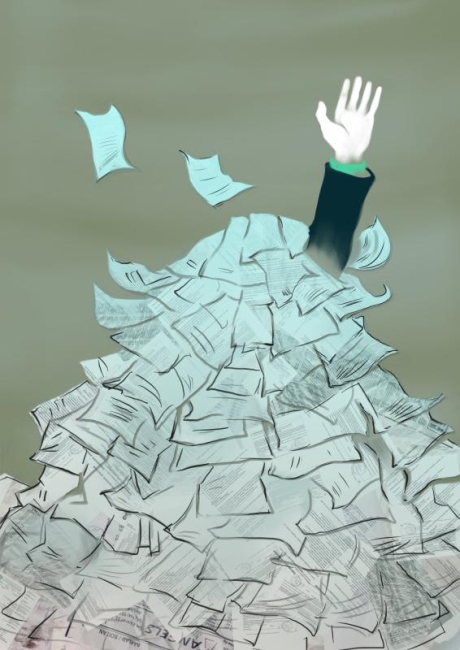You have /5 articles left.
Sign up for a free account or log in.

Fanatic Studio/royalty-free/Getty images
Department chairs and individuals in similar academic leadership positions serve a vitally important function across our institutions. On many campuses and within many departments, the chairperson is responsible for departmental administration and planning, faculty development, internal and external communication, personnel management, and student support.
In what some people might characterize as the tensions of “middle management,” these academic leaders are consumed with the busywork of day-to-day responsibilities and often caught between the diverging interests of faculty, on the one hand, and administration, on the other. In normal circumstances, the work of the department chair is often viewed as complicated, ambiguous, overwhelming and underappreciated. And as we have all come to realize, the context for department chairs over the last 18 months or so has been anything but normal.
The ongoing impact of the pandemic, racial issues, financial exigencies and other major challenges on department chairs has been substantial but inadequately explored. Thus, to research in some depth the perspectives of department chairs, I conducted a survey of chairs across the Big Ten institutions, which I described in a previous article, as well as a recent follow-up survey. Respondents in that follow-up survey included 114 chairs representing all of the Big Ten schools, and their responses and insights—which I will focus on in this piece—are instructive for academic leaders across the higher education landscape.
The survey reflects that leading through crisis has presented some distinct opportunities for those engaged in academic leadership. For example, as a result of serving as department chair during the 2020–21 academic year, nearly 75 percent of the respondents indicated that they are more confident in their crisis leadership abilities. About 65 percent of the chairs reported feeling better prepared and more secure in their ability to engage in difficult conversations. And, perhaps of little surprise, almost 95 percent said they were more confident in their capacity to facilitate virtual meetings.
Yet the survey data also showed that serving as department chair during an incredibly challenging academic year has led many to indicate limited confidence in the strategic direction of their institution and higher education in the United States more broadly. Additionally, only 22 percent of respondents agreed or strongly agreed that they would be more likely to serve another term as department chair, and when asked whether they are interested in future leadership opportunities in higher education, nearly half disagreed or strongly disagreed.
The survey asked chairs to consider in what ways they felt least prepared to address the various challenges of the last academic year. Their open-ended responses pointed to a wide array of challenges, including:
- The “lack of forethought and decisiveness” from leaders across the institution and the need to adapt to an endless stream of changing directives;
- The difficulty of motivating colleagues and supporting students in the midst of crisis;
- The barriers to leading effectively in a fully or partially remote environment; and
- The “emotional load” of serving as chair during such a difficult period.
As one respondent noted, “I don’t think that there was anything I could have done to prepare, and even long-serving chairs were ill-prepared for this year.”
Looking ahead to the work of this academic year, chairs were asked to reflect on how they might approach their roles differently. Many responded to this question by describing shifts in their individual leadership strategies, including the desire to be more communicative, flexible, decisive, empathetic and willing to delegate. One chair observed, “The skills that make a good department chair in a pandemic are largely the ones that make a good departmental chair at any time: sympathy and empathy and strong communication skills and a strong sense for fairness.”
The importance of effective communication appeared again in the following quote from another respondent: “It has made the importance of excellent communication more evident. We will continue to work to improve the quality of our communication and ensure it remains bi-directional. It has demonstrated the importance of having protocols and processes that are robust enough to work in times of crisis as well as during ‘normal’ times. We are continuing our efforts to ensure that our processes and protocols function effectively in all circumstances.”
Describing with great frequency their feelings of burnout, stress and exhaustion, numerous chairs emphasized a renewed commitment to stress management, work-life balance and wellness during the upcoming year. For example, a chair commented, “Honestly, I feel jaded and exhausted. I just hope I can muster the energy to struggle through this year.”
Pointing to a shift in thinking regarding the work required of chairpersons, another person noted, “The experiences of the last year have shifted my attention away from metrics of national recognition and brand building back towards creating and maintaining work-life harmony and setting realistic goals for individual circumstances in an equitable environment.”
Perhaps these comments from a respondent best sum up how many chairs view the past year: “It has changed everything. Every aspect of being in the trenches with my team has a different feel to it, and my response to individuals in my unit has me thinking more about how to work with each individual and their strengths within the collective.”
Providing an Infrastructure
Despite the success stories and lessons learned from leading during an unprecedented period, many of which the department chairs described in their responses, the data from this survey paint a picture of academic leaders in distress. Acknowledging the isolation of the role, the heightened demands, the emotional pressures and the ongoing uncertainty as we progress through another year of the pandemic, it is clear that department chairs and individuals in similar roles could benefit from focused opportunities for learning and development, as well as stronger linkages with other chairs navigating similar circumstances.
Such learning and development programs might include synchronous and asynchronous modules on general topics that are most germane to the department leader experience, in addition to networking opportunities, panel conversations and interactive roundtables with other department chairs. The colleges or universities could provide these opportunities, perhaps in collaboration with other, similar institutions.
Department chairs also need additional institutional support and greater clarity regarding their roles and responsibilities at their particular institution. That might include, perhaps, a handbook of policies and exemplary practices, a website with frequently asked questions, and contact information for relevant campus offices and a shared virtual platform for resource and idea sharing.
Given their proximity to the faculty and student experience and the desire for many to help shape institutional strategy, chairs should also have more opportunities to actively engage in high-level planning and priority setting for their school and institution. And perhaps above all, they should be given chances to focus on their personal well-being and renewal. Institutions might consider, for example, sponsoring a series of optional department leader–specific wellness programs, providing opportunities for the coaching or mentoring of department leaders and taking steps to recognize and reward the hidden or invisible labor associated with these roles.
In sum, each chair will have distinct needs and goals, and each institution and school may approach chair programming and support in different ways. But we can continue to learn from one another through providing an infrastructure that allows department chairs to heal, grow and succeed.








